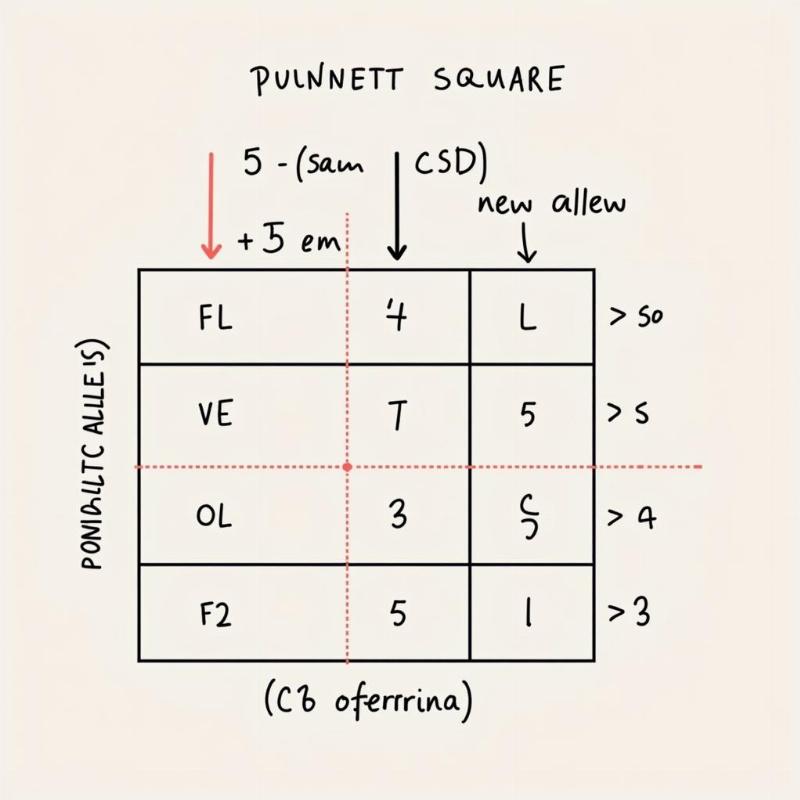Understanding the basics of canine genetics can be a powerful tool for responsible breeders and curious dog owners alike. Punnett squares offer a simple yet effective way to visualize how traits are inherited from one generation to the next. This guide will delve into the practical application of Punnett squares, specifically focusing on dog breeding and the prediction of various traits, from coat color to potential health concerns. Mastering this tool will equip you to make informed decisions about breeding practices and help you better understand your furry companion.
Decoding the Canine Genome: Punnett Squares Simplified
Punnett squares provide a visual representation of how genes combine during reproduction. Each parent contributes one allele (a variant form of a gene) for each trait. The Punnett square helps us predict the probability of offspring inheriting specific combinations of these alleles.  Punnett Square Basics
Punnett Square Basics
For instance, let’s consider coat color in Labrador Retrievers. Black (B) is dominant over chocolate (b). If you breed two black Labs, each carrying one B and one b allele (Bb x Bb), the Punnett square will show a 75% chance of black puppies (BB or Bb) and a 25% chance of chocolate puppies (bb). This simple example highlights the power of Punnett squares in predicting potential outcomes.
Predicting Coat Color and Other Traits with Punnett Square Practice
Beyond basic coat color, Punnett squares can be used to predict a variety of traits in dogs. These include everything from coat patterns (merle, brindle) to ear type (pricked, dropped). However, it’s crucial to remember that many traits are influenced by multiple genes, making predictions more complex.
For example, predicting coat color in breeds like French Bulldogs, with their diverse range of hues, involves considering multiple genes and their interactions. While Punnett squares can still be helpful, understanding the complex interplay of these genes requires further research and potentially genetic testing.
Punnett Squares and Canine Health: A Proactive Approach
Perhaps one of the most significant applications of Punnett squares in dog breeding lies in predicting the likelihood of inheriting certain genetic health conditions. Conditions like hip dysplasia, progressive retinal atrophy, and certain heart conditions have genetic components. By using Punnett squares, breeders can assess the risk of passing on these conditions to offspring.
Ethical breeders utilize genetic testing and Punnett square analysis to make informed breeding decisions, minimizing the risk of producing puppies with debilitating health problems. This proactive approach is vital for maintaining the health and well-being of future generations of dogs.
Conclusion
Punnett square practice is an invaluable tool for anyone interested in canine genetics, especially breeders. While simple in concept, it provides a powerful means of predicting the inheritance of various traits, from coat color to health conditions. By understanding and applying these principles, we can contribute to responsible breeding practices and ensure the health and well-being of our beloved canine companions. Utilizing this knowledge empowers us to make informed decisions and strive for healthier, happier dogs.
FAQ
- What is a Punnett square? A Punnett square is a diagram used to predict the genotypes of a particular cross or breeding experiment.
- How do I use a Punnett square for dog breeding? Identify the genotypes of the parents for the trait you are interested in. Then, use the Punnett square to combine the alleles and determine the probability of each genotype in the offspring.
- Can Punnett squares predict all dog traits? No, many traits are polygenic (influenced by multiple genes) and environmental factors can also play a role.
- Are there limitations to Punnett squares? Yes, Punnett squares are most accurate for single-gene traits. Complex traits are harder to predict.
- Where can I find more information about canine genetics? The American Kennel Club (AKC) and various veterinary resources offer valuable information about canine genetics.
- Why is understanding Punnett squares important for dog breeders? It allows them to make informed breeding decisions, potentially reducing the risk of genetic diseases in puppies.
- How can I use Punnett squares to understand my dog’s traits? While not always definitive, they can offer insights into the possible genetic makeup of your dog based on its parents’ traits.
Beautdogs.us – your trusted source for comprehensive dog care information in the US. We provide expert guidance on all dog breeds, from the common to the rare, along with in-depth knowledge on health care, nutrition, and training. Our platform offers practical advice on responsible pet ownership, including legal considerations and financial planning. We also review and recommend quality pet products, from food to grooming supplies. Whether you’re a new dog owner or a seasoned expert, Beautdogs.us is your go-to resource for all things canine. When you need further support, contact us via email at [email protected] for detailed assistance.